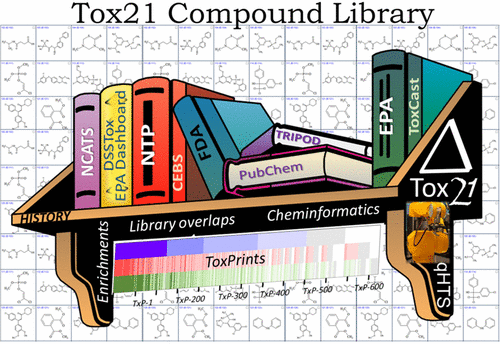当前位置:
X-MOL 学术
›
Chem. Res. Toxicol.
›
论文详情
Our official English website, www.x-mol.net, welcomes your
feedback! (Note: you will need to create a separate account there.)
The Tox21 10K Compound Library: Collaborative Chemistry Advancing Toxicology
Chemical Research in Toxicology ( IF 3.7 ) Pub Date : 2020-11-03 , DOI: 10.1021/acs.chemrestox.0c00264 Ann M Richard 1 , Ruili Huang 2 , Suramya Waidyanatha 3 , Paul Shinn 2 , Bradley J Collins 3 , Inthirany Thillainadarajah 4 , Christopher M Grulke 1 , Antony J Williams 1 , Ryan R Lougee 1, 5 , Richard S Judson 1 , Keith A Houck 1 , Mahmoud Shobair 1 , Chihae Yang 6, 7 , James F Rathman 6, 7 , Adam Yasgar 2 , Suzanne C Fitzpatrick 8 , Anton Simeonov 2 , Russell S Thomas 1 , Kevin M Crofton 1, 9 , Richard S Paules 3, 3 , John R Bucher 3 , Christopher P Austin 2 , Robert J Kavlock 1, 10 , Raymond R Tice 3, 11
Chemical Research in Toxicology ( IF 3.7 ) Pub Date : 2020-11-03 , DOI: 10.1021/acs.chemrestox.0c00264 Ann M Richard 1 , Ruili Huang 2 , Suramya Waidyanatha 3 , Paul Shinn 2 , Bradley J Collins 3 , Inthirany Thillainadarajah 4 , Christopher M Grulke 1 , Antony J Williams 1 , Ryan R Lougee 1, 5 , Richard S Judson 1 , Keith A Houck 1 , Mahmoud Shobair 1 , Chihae Yang 6, 7 , James F Rathman 6, 7 , Adam Yasgar 2 , Suzanne C Fitzpatrick 8 , Anton Simeonov 2 , Russell S Thomas 1 , Kevin M Crofton 1, 9 , Richard S Paules 3, 3 , John R Bucher 3 , Christopher P Austin 2 , Robert J Kavlock 1, 10 , Raymond R Tice 3, 11
Affiliation

|
Since 2009, the Tox21 project has screened ∼8500 chemicals in more than 70 high-throughput assays, generating upward of 100 million data points, with all data publicly available through partner websites at the United States Environmental Protection Agency (EPA), National Center for Advancing Translational Sciences (NCATS), and National Toxicology Program (NTP). Underpinning this public effort is the largest compound library ever constructed specifically for improving understanding of the chemical basis of toxicity across research and regulatory domains. Each Tox21 federal partner brought specialized resources and capabilities to the partnership, including three approximately equal-sized compound libraries. All Tox21 data generated to date have resulted from a confluence of ideas, technologies, and expertise used to design, screen, and analyze the Tox21 10K library. The different programmatic objectives of the partners led to three distinct, overlapping compound libraries that, when combined, not only covered a diversity of chemical structures, use-categories, and properties but also incorporated many types of compound replicates. The history of development of the Tox21 “10K” chemical library and data workflows implemented to ensure quality chemical annotations and allow for various reproducibility assessments are described. Cheminformatics profiling demonstrates how the three partner libraries complement one another to expand the reach of each individual library, as reflected in coverage of regulatory lists, predicted toxicity end points, and physicochemical properties. ToxPrint chemotypes (CTs) and enrichment approaches further demonstrate how the combined partner libraries amplify structure–activity patterns that would otherwise not be detected. Finally, CT enrichments are used to probe global patterns of activity in combined ToxCast and Tox21 activity data sets relative to test-set size and chemical versus biological end point diversity, illustrating the power of CT approaches to discern patterns in chemical–activity data sets. These results support a central premise of the Tox21 program: A collaborative merging of programmatically distinct compound libraries would yield greater rewards than could be achieved separately.
中文翻译:

Tox21 10K 化合物库:协作化学推进毒理学
自 2009 年以来,Tox21 项目已在 70 多项高通量检测中筛选了约 8500 种化学物质,生成了超过 1 亿个数据点,所有数据均通过美国环境保护署 (EPA)、国家环境保护中心的合作伙伴网站公开提供。推进转化科学 (NCATS) 和国家毒理学计划 (NTP)。支持这一公共努力的是有史以来最大的化合物库,专门用于提高对跨研究和监管领域毒性化学基础的理解。每个 Tox21 联邦合作伙伴都为合作伙伴带来了专门的资源和能力,包括三个大小大致相等的化合物库。迄今为止生成的所有 Tox21 数据都是用于设计、筛选和分析 Tox21 10K 库的想法、技术和专业知识的综合成果。合作伙伴的不同计划目标产生了三个不同的、重叠的化合物库,这些化合物库合并后不仅涵盖了化学结构、用途类别和特性的多样性,而且还包含了许多类型的化合物重复。描述了 Tox21“10K”化学库的开发历史以及为确保化学注释质量并允许进行各种再现性评估而实施的数据工作流程。化学信息学分析展示了三个合作伙伴文库如何相互补充以扩大每个单独文库的范围,这反映在监管列表的覆盖范围、预测的毒性终点和理化特性上。 ToxPrint 化学型 (CT) 和富集方法进一步证明了组合的合作伙伴库如何放大原本无法检测到的结构-活性模式。 最后,CT 富集用于探测 ToxCast 和 Tox21 组合活动数据集中相对于测试集大小以及化学与生物终点多样性的总体活动模式,说明 CT 方法辨别化学活动数据集中模式的能力。这些结果支持了 Tox21 计划的核心前提:以编程方式不同的化合物库的协作合并将产生比单独实现更大的回报。
更新日期:2020-11-03
中文翻译:

Tox21 10K 化合物库:协作化学推进毒理学
自 2009 年以来,Tox21 项目已在 70 多项高通量检测中筛选了约 8500 种化学物质,生成了超过 1 亿个数据点,所有数据均通过美国环境保护署 (EPA)、国家环境保护中心的合作伙伴网站公开提供。推进转化科学 (NCATS) 和国家毒理学计划 (NTP)。支持这一公共努力的是有史以来最大的化合物库,专门用于提高对跨研究和监管领域毒性化学基础的理解。每个 Tox21 联邦合作伙伴都为合作伙伴带来了专门的资源和能力,包括三个大小大致相等的化合物库。迄今为止生成的所有 Tox21 数据都是用于设计、筛选和分析 Tox21 10K 库的想法、技术和专业知识的综合成果。合作伙伴的不同计划目标产生了三个不同的、重叠的化合物库,这些化合物库合并后不仅涵盖了化学结构、用途类别和特性的多样性,而且还包含了许多类型的化合物重复。描述了 Tox21“10K”化学库的开发历史以及为确保化学注释质量并允许进行各种再现性评估而实施的数据工作流程。化学信息学分析展示了三个合作伙伴文库如何相互补充以扩大每个单独文库的范围,这反映在监管列表的覆盖范围、预测的毒性终点和理化特性上。 ToxPrint 化学型 (CT) 和富集方法进一步证明了组合的合作伙伴库如何放大原本无法检测到的结构-活性模式。 最后,CT 富集用于探测 ToxCast 和 Tox21 组合活动数据集中相对于测试集大小以及化学与生物终点多样性的总体活动模式,说明 CT 方法辨别化学活动数据集中模式的能力。这些结果支持了 Tox21 计划的核心前提:以编程方式不同的化合物库的协作合并将产生比单独实现更大的回报。











































 京公网安备 11010802027423号
京公网安备 11010802027423号